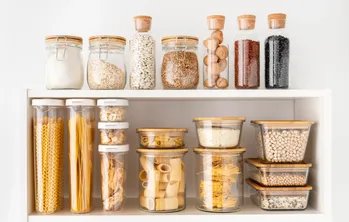Gone are the days when a weekly grocery shopping spree didn't seem like such a big deal. With the rising cost of groceries, it's becoming increasingly challenging for families to make ends meet, especially those on tight budgets. However, there is a way out: pantry staples! These essential food items can be stocked up and stored for an extended period, providing you with a range of meals throughout the week without breaking the bank. In this article, we'll be highlighting ten frugal pantry staples that will help you slash your grocery bill and keep your family fed.
Rice
Rice is an affordable carbohydrate source that can be used in various dishes, including rice bowls, casseroles, soups, and stir-fries. One cup of cooked rice costs roughly $0.25 and provides approximately 200 calories. It's a versatile ingredient that can be seasoned to taste, making it suitable for all preferences.
Moreover, rice has a long shelf life; once opened, it can last up to six months in the pantry or one year in the freezer. This makes it an excellent choice for bulk buying, which is cheaper in the long run. Additionally, rice can be paired with other budget-friendly ingredients like vegetables, spices, and beans to create filling meals that are both nutritious and satisfying.
Beans and Legumes
Beans and legumes offer an affordable protein source compared to meat alternatives such as chicken or beef. One cup of cooked lentils costs roughly $0.25, providing approximately 18 grams of protein, while a cup of black beans costs around $0.33 and provides over 15 grams of protein. These legumes are also rich in fiber, making them an excellent choice for promoting healthy digestion.
Moreover, beans and legumes have a long shelf life when stored correctly, allowing you to buy them in bulk and save money in the long run. They can be used in various dishes such as soups, stews, salads, and dips, making them a versatile addition to your pantry.
Pasta
Pasta is an affordable carbohydrate source that can be paired with budget-friendly ingredients like vegetables, spices, and sauce to create satisfying meals. One pound of pasta costs roughly $1.00 and provides approximately 400 calories. It's a versatile ingredient that can be seasoned to taste and stored in the pantry for up to one year.
Moreover, pasta can be paired with other pantry staples like canned tomatoes, garlic, onions, and olive oil to create delicious meals such as spaghetti sauce and marinara dishes. It's also a suitable choice for busy weeknights when you need a quick meal without breaking the bank.
Canned Tomatoes
Canned tomatoes are an affordable ingredient that can be used in various dishes, including sauces, soups, stews, and pasta dishes. A 28-ounce can costs roughly $1.00 and provides approximately 35 calories per serving. This makes it an excellent choice for adding flavor to your meals without adding too many calories.
Moreover, canned tomatoes have a long shelf life, allowing you to buy them in bulk and save money in the long run. They're also versatile ingredients that can be paired with other pantry staples like garlic, onions, and herbs to create delicious meals without breaking the bank.
Canned Vegetables
Canned vegetables offer an affordable way to add nutrients to your meals, especially during the offseason when fresh produce is scarce or expensive. A 14-ounce can costs roughly $0.75 and provides approximately 20 calories per serving. They're a suitable choice for adding texture and flavor to soups, stews, casseroles, and pasta dishes.
Moreover, canned vegetables have a long shelf life, allowing you to buy them in bulk and save money in the long run. They're also versatile ingredients that can be paired with other pantry staples like rice, beans, and spices to create filling meals without breaking the bank.
Canned Soup
Canned soup is an affordable meal option that provides both nutrition and convenience. A 14-ounce can costs roughly $0.75 and provides approximately 200 calories per serving. They're a suitable choice for busy weeknights when you need a quick meal without breaking the bank.
Moreover, canned soup is versatile and can be paired with other pantry staples like rice, beans, and spices to create filling meals without adding too many calories. It's also a suitable choice for adding flavor to your meals when fresh produce is scarce or expensive.
Crackers
Crackers are an affordable snack option that can be paired with other pantry staples like cheese, peanut butter, and jelly to create quick and easy meals. A 16-ounce box costs roughly $2.00 and provides approximately 140 calories per serving. They're a suitable choice for adding crunch and texture to your meals without adding too many calories.
Moreover, crackers have a long shelf life, allowing you to buy them in bulk and save money in the long run. They're also versatile ingredients that can be paired with other pantry staples like rice, beans, and spices to create filling meals without breaking the bank.
Pasta Sauce
Pasta sauce is an affordable ingredient that can be used to add flavor to your pasta dishes. A 24-ounce jar costs roughly $1.50 and provides approximately 20 calories per serving. They're a suitable choice for adding flavor to your meals without adding too many calories.
Moreover, pasta sauce is versatile and can be paired with other pantry staples like rice, beans, and vegetables to create filling meals without breaking the bank. It's also a suitable choice for adding flavor to your meals when fresh produce is scarce or expensive.
Oats
Oats are an affordable grain option that can be used to create quick and easy breakfast options. A 16-ounce box costs roughly $2.00 and provides approximately 150 calories per serving. They're a suitable choice for adding fiber and nutrition to your meals without breaking the bank.
Moreover, oats are versatile and can be paired with other pantry staples like fruit, nuts, and spices to create flavorful breakfast options. It's also a suitable choice for adding texture to your meals when fresh produce is scarce or expensive.
FAQ section
Q: What are some affordable meal options that I can incorporate into my diet?
A: Some affordable meal options include oats, rice, beans, pasta, vegetables, fruits, eggs, peanut butter, and soup. These items can be found at local grocery stores for a low cost and can be used to create delicious and nutritious meals.
Q: How can I make my meals more flavorful without adding too many calories?
A: You can add flavor to your meals by using spices, herbs, and seasonings instead of added sugars or salt. Try experimenting with different combinations of cumin, garlic, paprika, chili powder, and oregano to create unique flavors.
Q: What are some ways to reduce food waste in my household?
A: There are several ways to reduce food waste, including meal planning, making a grocery list, buying only what you need, storing food properly, freezing excess items, and using leftovers for future meals. You can also donate unused food to local food banks or compost food scraps instead of throwing them away.
Q: How can I ensure that my diet is nutritionally balanced without spending a lot of money?
A: By focusing on whole foods and incorporating a variety of foods from each food group, you can create a balanced and nutritious diet without breaking the bank. Try to include lean protein sources, such as chicken or beans, complex carbohydrates like brown rice or quinoa, and plenty of fresh fruits and vegetables in your meals.
Q: How can I make sure that my pantry is always stocked with affordable staples?
A: You can create a list of pantry staples, such as pasta, rice, beans, canned tomatoes, and canned fruit, and buy these items in bulk when they are on sale. This will ensure that you always have these items on hand for quick and easy meals, reducing the need to spend money on more expensive meal options.
Q: How can I find discounts or sales at my local grocery store?
A: Many grocery stores offer weekly flyers or digital coupons that can help you save money on your groceries. You can also check online for deals and promotions, or sign up for loyalty programs that offer additional discounts for frequent shoppers.
Q: How can I make sure that my meals are diverse and interesting without spending a lot of time in the kitchen?
A: By using simple cooking techniques, such as roasting vegetables, sautéing ingredients in a pan, or boiling grains, you can create delicious and varied meals without spending too much time in the kitchen. You can also try meal prepping on weekends to make it easier to pack nutritious lunches for work during the week.
Q: How can I ensure that my diet is balanced when eating vegetarian or vegan meals?
A: By incorporating a variety of plant-based protein sources, such as legumes, nuts, and seeds, you can create balanced and nutritious vegetarian or vegan meals. You can also try adding nutritional yeast or fortified plant-based milks to your diet for additional protein and calcium.
Q: How can I make sure that my meals are satisfying and filling without consuming too many calories?
A: By incorporating fiber-rich foods, such as whole grains, fruits, and vegetables, you can create satisfying and filling meals without consuming too many calories. You can also try adding healthy fats, such as avocado or nuts, to your meals to provide a sense of fullness.
Q: How can I make sure that my meals are enjoyable and flavorful despite the need to stick to a budget?
A: By experimenting with different spices, herbs, and seasonings, you can create delicious and flavorful meals without breaking the bank. You can also try using fresh ingredients, such as garlic or lemon juice, to add flavor to your dishes. Finally, don't be afraid to get creative and try new recipes or cooking techniques!
In conclusion, by incorporating these affordable meal options into your diet, you can save money while still maintaining a healthy lifestyle. By focusing on whole foods, avoiding processed items, and using spices and herbs to add flavor, you can create delicious and nutritious meals that won't break the bank. Remember to always check for sales and discounts at your local grocery store to further reduce costs.











